|
Coastal
Fringe: Southwick,
Shoreham, Lancing and East Worthing Beaches
Shoreham
Beach is a shingle spit about three miles long, separated from town of
Shoreham-by-Sea (Sussex) by the River
Adur, which been has deflected eastwards by the longshore
drift over the centuries. Wood and rock groynes have been installed
to stabilise the moving shingle and to minimise erosion and prevent flooding.
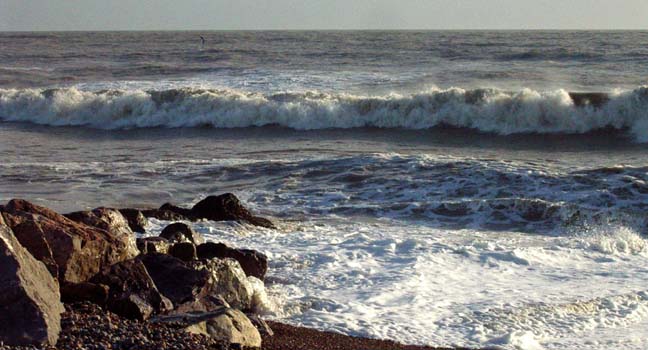
Waves
rolling in over the sand flats of Lancing
on
a high spring tide
From
the turn of the century the creeping permanent development and re-development
of the natural fringing beach at Shoreham has gradually covered the main
shingle bank, leaving a narrow strip, squeezed between houses and sea.
This
flat strip of seemingly lifeless pebbles that has once more held out against
a winter sea, is set to surprise and delight us, as seeds and roots of
last years flowering respond to longer days, and find nourishment and moisture.
In April and early May they burst upon us with a brilliant flowering border
adapted to the harsh conditions.
by
David Wood (Shoreham Beach)
 Birds
of the Shingle Birds
of the Shingle
Crow
Ringed
Plover
Cormorant
Black-headed
Gull
Starling
Pied
Wagtail
NEWS
AND EVENTS
Link
to the Coastal Wildlife Reports for 2005
 29
December 2004 29
December 2004
An
old dessicated mushroom (photographed on the right) found on an old wooden
groyne on the shingle part of Shoreham Beach near the kiosk at the eastern
end of Widewater Lagoon car park was possibly
a species of Agrocybe.
It was incongruous on the beach, but it looked like a common species on
a poor condition, so I did not stop to examine it closely.
 3
November 2004 3
November 2004
A
large mushroom was spotted on Lancing beach by the sailing club building,
on the shingle but where some soil has collected against the wooden fence
boundary between the shingle and the concrete path. It was the species
which is distinctive because of the presence of a volva
from which the tapering stipe (stem) grows. It was the easily identified
Volvariella
gloiocephala. This species is sometimes
known as the Straw Mushroom,
Volvariella
speciosa (its old name).
Fungi
of Shoreham
There
were two chirms of Goldfinches
by the scrub next to Widewater of eight
and five birds respectively.
20
October 2004
As
the weather changes the birds are on the move. Two chirms of Goldfinches
arrived One flock over the wild wasteland area between Widewater
Lagoon and the beach huts and the sea, numbered at least 16 finches
but in the second group over Lancing Beach Green there were only eight
birds. There were a handful of pipits, looking more like Rock
Pipits than the commoner Meadow
Pipits.
22
September 2004
On
an overcast day with a Strong Breeze from the south-west, there wasn't
anything of special note. The pink of the Thrift
was still to be see on the Widewwater Lagoon
flood plain east of the bridge. And Common
Mallow was still in flower with the red berries
of Bittersweet
14
September 2004
After
the morning gales, but still with a strong
Breeze (Force 6)
three Crows
were dropping shellfish (molluscs, probably
mussels)
from a height on to Lancing Beach Green
beach below, one dropping their prey on to the new rock sea defences in
an attempt to break open the shells.
25
August 2004
It
seemed if the dragonfly flew in off the sea
as the flight was a rapid south to north over a narrow area of beach shingle
near Lancing Sailing Club (between Beach Green, Lancing, and Widewater).
The
Southern
Hawker, Aeshna cyanea, had caught
a Small White Butterfly
and flew around for about a minute until it chose the first place of rest
on the temporary fencing erected by the sea defence contractors. Mandibles
crunching away, it consumed its butterfly prey just like a hungry crab
and after two minutes the prey had been eaten and the dragonfly flew northwards.
Of course, the Southern Hawker
could have just visited the beach area to prey on the numerous Small
White Butterflies, with caterpillars that
feed on the Sea Kale.
Adur
Damselflies
and Dragonflies
An
immigrant Painted Lady Butterfly
was resting nearby.
8
July 2004
Two
Peregrine
Falcons sparred over the top of the power station in Shoreham Harbour
at 9:00 am on
an overcast morning in a gap between the rain showers. They appeared from
behind the chimney where the nestbox faces south and chased each other
over the main power station building landing on the roof between their
spars.
Report
by Peter Talbot-Elsden (Southwick)
Southwick
Nature
5 July
2004
The
Silver
Ragwort flowers on Shoreham Beach as the
shingle plants are now past the best display.
16
June 2004
The
blue of the Viper's Bugloss
contrasted with the yellow of one of the Stonecrops,
of which at least two species of Sedum
are found on the beach shingle.
5
June 2004
ADUR WORLD OCEANS
DAY
Venue:
Coronation Green,
Shoreham-by-Sea
Adur
was one of the leaders in the United Kingdom when it presented an Exhibition
celebrating the official World Oceans Day. It was
held in the large marquee on
Coronation
Green overlooking the River
Adur.
David
and Marion Wood brought along a living Starry
Clover, Trifolium
stellatum,
plant. This naturalised flower is now only known from Shoreham beach.
The
most interesting discovery was a sea urchin fossil (base of the spines
which have broken off) found on Shoreham beach and brought in by a young
girl. This is illustrated on the right.
I estimated
the attendance on a sunny day (21.4° C)
at 3,500 (estimates of attendances at other events have been overstated).
1
June 2004
On
the western side of the local Adur Council boundaries the Worthing Council
has for years rigorously adopted a policy of weeding out any plants that
had taken root on the shingle. Still, remarkably a few hardy colonisers
had withstood the onslaught, including the straggly yellow plant in the
photographs below.
This
yellow crucifer with beaked fruits, erect sepals, and clasping upper leaves,
I'd
suggest
Wild
Turnip,
Brassica
rapa.
31
May 2004
The
perfume and flower colour is best on the shingle above the high tide mark
during June.
| The
blue
of
Viper's
Bugloss contrasts nicely with red Common
Poppies and
Yellow-horned
Poppies.
Location:
next to the beach huts south of Shoreham Beach
Green
The
small bank is an earth barrier to discourage travellers. And the common
shingle plants are the first to colonise. |
 |
11
May 2004
A
male Whinchat
was singing in the fog from the Carrot's Cafe car park, by Shoreham Harbour
Power Station (at Southwick) in the early morning rush hour.
5
May 2004
The
high spring tides had pushed five Turnstones
on to the ridge of shingle on Lancing Beach
(near Brooklands) but they were even harder
to distinguish than the Ringed Plovers
in the same place on 21
April 2004. There were dozens of whelk
balls (disused egg cases of the Common Whelk)
on the strandline where the Turnstones
dipped over the ridge to feed. One bird was actually observed turning over
a pebble as befits its common name.
1 May
2004
Three
sleek birds of prey flew in under the mist on Southwick
beach. These were a complete surprise and identified as immigrant Hobbies.
Report
by June Brown
22
April 2004
There
was a considerable amount of bird activity on the shingle close to the
beach huts near Shoreham Beach Green. I fastened my binoculars and tried
to find the birds that were well camouflaged against the pebbles. The first
birds seen were a handful of Wheatears
very alert and upright. There was too much human disturbance and there
were two groups of much smaller birds. The first turned out to be House
Sparrows but the second group were more
vocal and restless. One of the birds sang from the roof of one of the beach
huts and then its red speckly breasts revealed these birds as Linnets.
21
April 2004

The
high spring tides had pushed the Ringed
Plover on to the ridge of shingle on Lancing
Beach (near Brooklands) but you will have
to look carefully at the photograph above to spot the well camouflaged
little bird.
13
April 2004
A
small greenish-brown bird made a short flight immediately in front of me
as I cycled past Widewater. It was nestled
down amongst the shingle and its camouflage was not all that successful.
When it scrambled to action stations it looked exhausted. This bird was
most likely an immigrant Chiffchaff,
but
it did not call.
5
April 2004
Battered
by the blustery south-westerly breeze, the clump of six-petalled
white flowers in the "daffodil zone" on the grass verges of the beach shingle
by the Church of Good Shepherd on Shoreham Beach were bent almost horizontal
by the wind. Initially the plant was wrongly identified as the Star
of Bethlehem,
Ornithogalum
umbellatum, probably a garden escape of a pretty plant that has
been known in England since 1548. It is not usually thought of as a native
plant but it has been naturalised for a long time and known in Sussex for
two centuries.

NB:
These could be the introduced bluish-white
variety of the garden plant known as the Spring
Starflower,
Ipheion
uniflorum. C.A.Stace
gives its name as Tristagma uniflorum.
Discussion
on UK Wildlife Yahoo Group
 30
March 2004 30
March 2004
Locally,
they way be known as Wall Lizards because of their frequency of inhabiting
old flint walls, and under the blue cloudless sky, over fifty (counted
38 avoiding duplicates and then estimated) lizards skittered up the extensive
crumbling south and west facing flint walls of the Old Fort (Shoreham
Beach) (TQ 234 046) with
dexterity, very quickly (too quickly to photograph) after basking in the
warmth of the morning sun.
There
was one particularly large lizard and I would estimate its length (excluding
its long tail) at 60 mm. Most were much smaller appearing about half the
size at 40 mm.
All
these lizards would drop into the grass or hide in a crevice if disturbed.
They were only to be found near tufts of grass. Although they skittered
over the vertical walls with ease, they only occupied the lower flint levels.
All the lizards seen had their full tails.
Old
Fort Photographs (More Lizard Images)
Photograph
of a European Wall Lizard (from the Isle of Wight)
Common
Lizard Photographs
-
1.
Wall Lizards have slightly larger heads and longer legs than Common Lizards
-
2.
They often have very thin bands with alternating black and white sections
on their tails (like rings around the tail but only apparent down the sides
of the tail, not all round)
-
3.
The Lizards in this colony seem to have come from Northern Italy and have
the bright green backs of the sub-species found there.
-
4.
While Common Lizards prefer dense grassy or heathy habitat the Wall Lizard
is strongly associated with dry stony habitat with a vertical component,
and is often found basking high up on its wall (sometimes up on roof tops)
-
5.
Finally, the scales on the Wall Lizard are smaller than those on a Common
Lizard giving a smoother skinned effect (I don't know how noticeable this
is!)
Ralph
Hollins' Nature Notes
Postscript:
these lizards have now been definitely identified as the Wall
Lizard, Podarcis
muralis.
Local
Lizard Comparison Photographs
29
March 2004
A
Small
Tortoiseshell Butterfly with a reddish
hue was my first of the year seen on the Childing
Pink patch of Silver Sands, Shoreham Beach
east. This is likely to be an immigrant and confirms my suspicion that
the reddish hued specimens are either immigrants or old butterflies emerging
from hibernation, or both.
At
least three Wheatears
seemed to have just flown in by the Old Fort, near the western arm of Shoreham
Harbour entrance at the far eastern end of Shoreham beach. These attractive
birds were well camouflaged against the shingle but could be seen clearly
through the binoculars when standing on posts and, of course, they were
immediately recognisable by there white rear when they flew off.

At
least two lizards in the grass by the Old Fort (TQ
234 046) seemed to have a slight greenish
tinge to their head and underside, were very darkly patterned with black
on brown, about 35 mm long (excluding the long tail) and a total length
estimated at 90 mm. I had a close look without being conversant with the
identifying features. I have always thought that these lizards were the
Common
(or Viviparous) Lizard, Zootoca
vivipara. However, it seems at least
superficially, they can match the photographs
of
the European Wall Lizard, Podarcis
muralis. The legs in the Old Fort
specimens
were speckled with black. However, these species look almost identical
to each other to the inexperienced herpetologist.
"Wall
Lizards have a straight collar, which distinguishes them from Sand and
Viviparous Lizards which have collars with serrated edges."
Wall
Lizards of Europe
Wall
Lizard Photographs
Postscript:
these lizards have now been definitely identified as the Wall
Lizard, Podarcis
muralis.
24
March 2004
There
were four Turnstones
on the rock (syenite) sea defences by Widewater
Lagoon on the high spring tide,
and at least three Great Crested Grebes
swimming offshore.
21
March 2004
Five
green lizards were discovered on a wall on Shoreham Beach (not at Shoreham
Old Fort). These have now been identified as the European Wall Lizard,
Podarcis
muralis.
18
March 2004
On
the ridge of the shingle by the beach huts a female
Black
Redstart stood out where I would expect
to see a Ringed Plover.
A pair of Ringed Plovers
were together on gravel by the pipeline outlet into Widewater
Lagoon with a feeding Little Egret.
Another Little Egret
stood statuesque like a Heron
just to the west of the bridge over the lagoon, (where the gardens were
up to World War II).
16
March 2004
11
Wheatears
and 2 Black Redstarts
(one a male) were seen on the shingle beach just west of Beach Green, Shoreham
Beach between 4.15 - 4.45 pm.
BTO
Migration Watch
12
March 2004
As
the rain tipped down in the early evening (before the light faded) the
Peregrine
Falcon was perched on one of the ledges on the Shoreham Harbour Power
Station chimney for a few minutes,
Report
by Peter Talbot-Elsden (Southwick)
2
March 2004
A Slavonian
Grebe, Podiceps
auritus, was seen in summer
plumage off the Church of the Good Shepherd on Shoreham Beach in the afternoon.
Slavonian
Grebes have been reported before off Shoreham
Beach. The Sussex
Ornithological Society have
this bird classified as a scarce Winter Visitor and Passage Migrant. This
colourful grebe is one of the lesser known of the British birds, observed
to visit estuaries and the shallow seas in severe weather when their home
freshwater ponds are frozen. It feeds on fish. Over seventy pairs breed
in Scotland.
1
March 2004
The
Peregrine Falcon has just landed on the Shoreham Harbour Power Station
chimney, near the nest box, at 3:54 pm.
Report
by Peter Talbot-Elsden (Southwick)
Southwick
Nature 2004
11
February 2004
A
Painted
Lady Butterfly is seen flying at about
8 mph against a light breeze (about 6 mph) from the north-west near
Lancing Beach Green (by the Sailing Club where the path narrows between
the green and Widewater Lagoon). This butterfly
appears to be an immigrant, probably
on the long journey from Africa, possibly from France.
Other
Reports of Painted Ladies (Adur Nature Notes: February 2004)
Strong
evidence for Immigration of Painted Ladies
10
February 2004
Whilst
observing a gull hanging in the air and finally settling on the undulating
sea, a
Sandwich Tern, Sterna
sandvicensis, flew arrow-like a purposely
over the shallow sea (at high tide) parallel with Southwick beach before
disappearing out of view to the west. Terns
are unusual in the winter months.
3
February 2004
After
the gales of the last few days, I walked the strandline
on Southwick Beach in a temperature of 15.1°
C but there was nothing remotely exceptional
apart from a single dead and washed up Auk.
However, in the winter months the offshore passage of Guillemots
and Razorbills
is high so an occasional washed up casualty is to be expected. Whelk
egg balls were present and it would be surprising
if they weren't and  some
were probably blown even further inland. Dead shells include the usual
Slipper
Limpets,
Mussels,
Venerids,
Oysters, Scallops with the occasional Limpet
and Cuttlebone. some
were probably blown even further inland. Dead shells include the usual
Slipper
Limpets,
Mussels,
Venerids,
Oysters, Scallops with the occasional Limpet
and Cuttlebone.
BMLSS
Molluscs
Oyster
& the Slipper Limpet
BMLSS
Beachcombing
BMLSS
Sea Birds
28
January 2004
Two
small flocks of sea birds of birds whirled low over the sea off Brooklands
Boating Lake which
was just beginning to show sand. The swiftly flying flocks numbered about
200 and they have seen before and not mentioned. They are almost certainly
Sanderling
which are seen over the sand at low tide
and were recorded only five days earlier.
23
January 2004
A flock of
200+
Sanderling were
feeding on the sandy beach next to the sea off Brooklands
Boating Lake. This
area is noted for Sanderling,
but
this large number was exceptional.
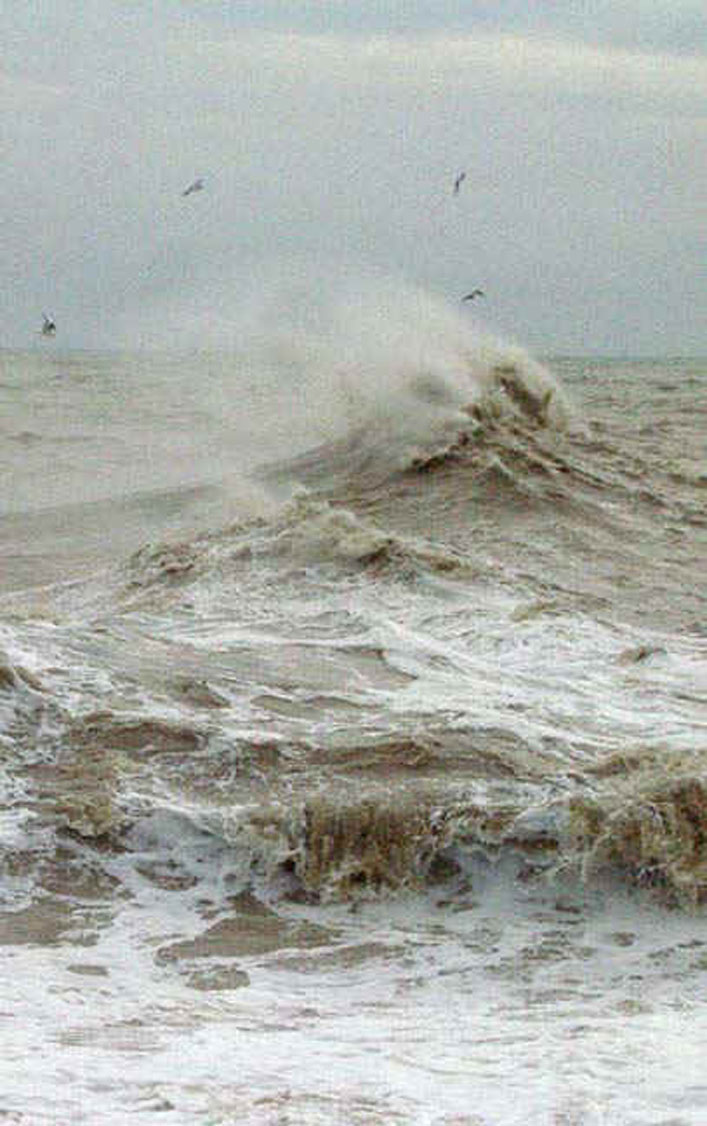 13
January 2004 13
January 2004
Turnstones
are now a familiar sight on the shingle shores of Shoreham beach in the
winter. Just one twittered as it flew past: the call is now recognisable
through familiarity.
3
January 2004
Six
Purple
Sandpipers were inside the west arm of
Shoreham harbour entrance (on the Old Fort side) on a falling tide. If
the tide is low these birds sometimes get on the square concrete platform
just outside the base of the west arm. At high tide they sometimes roost
on the wooden 'crash barriers' immediately opposite the blockhouse but
again they were not there last time I looked at a high tide (and
are
pretty distant then anyway). So on current experience I'd say try the wooden
pier/west arm when tide is halfway in or out but don't expect to be lucky
first time.
Full
Message on Sussex Birds

Coastal
Reports to 2003 (Link)
Intertidal
2004

EMail
Address for sending in wildlife reports from the lower Adur valley
Only
a selection will be included and only reports with the name of the reporter
Chalk
&
Flint
About
85 million years ago Sussex was covered by a warm sea. Sedimentary deposits
of coccoliths (microscopic plankton with a calcium carbonate shell) laid
down the chalk which is the rock of the South Downs of south-east England.
The flint probably formed from the dissolved remains of ancient sponge
siliceous spicules and was deposited at a later date into gaps and beds
in the chalk when the silica then solidified. When the friable chalk was
eroded the flint remained, subsequently rounded into spherical and ovoid
pebbles by the action of the waves grinding the pebbles against each other.
(simplified
explanation for upper layers of chalk)
Chalk
Facts
Fossil
Sea Urchin Echinocorys scutatus
Fossil
Bivalve Spondylus spinosa (pic).
Butterflies:
| Clouded
Yellow * |
Colias
croceus |
| Large White |
Pieris brassicae |
| Common
Blue

|
Polyommatus
icarus |
| Small White |
Pieris rapae |
| Small
Tortoiseshell * |
Aglais urticae |
| Red
Admiral * |
Vanessa atalanta |
| Painted
Lady * |
Vanessa cardui |
| |
|
| *
Immigrants or hibernators |
|
| Whites
caterpillars feed on |
Sea
Kale |
| Blue
caterpillars feed on |
Bird's
Foot Trefoil |
Adur
Valley Butterflies
Link
to FLOWERING PLANTS OF THE SHINGLE |


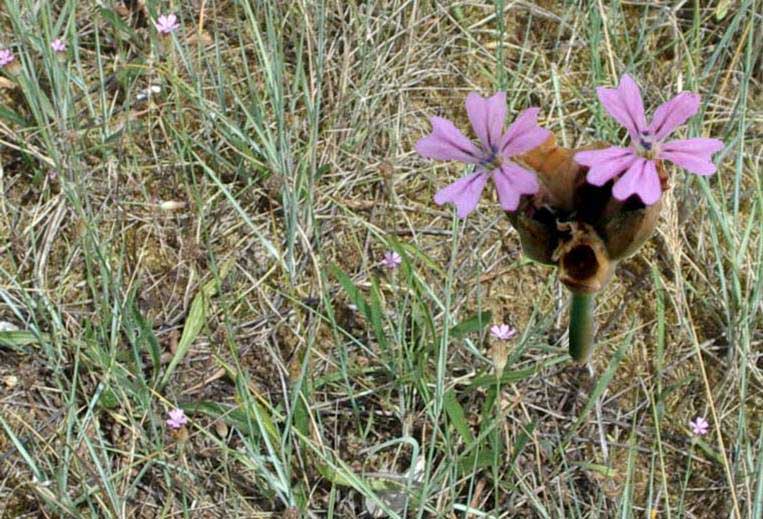
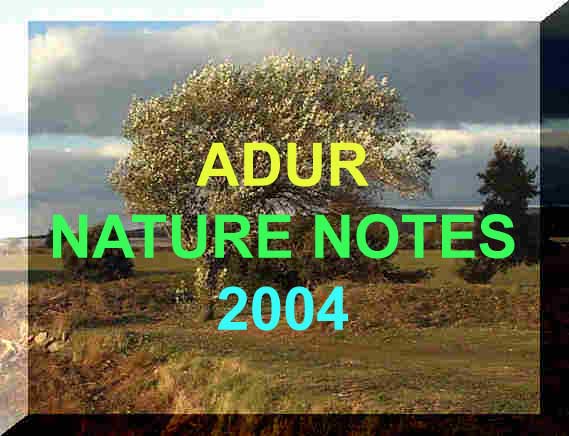















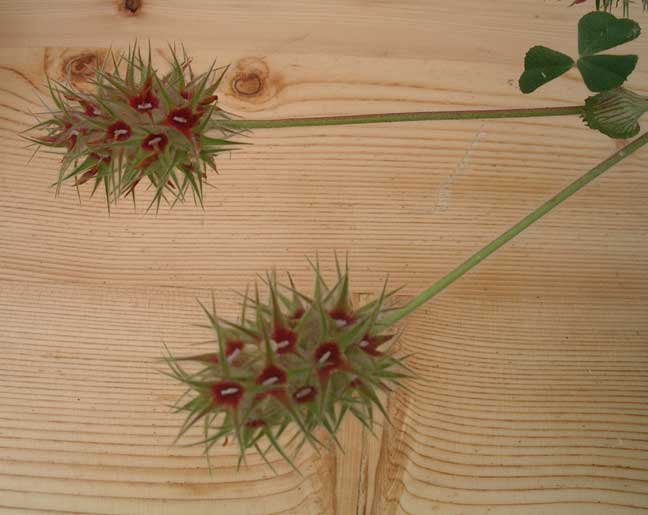








 13
January 2004
13
January 2004


